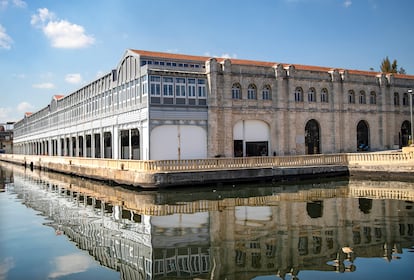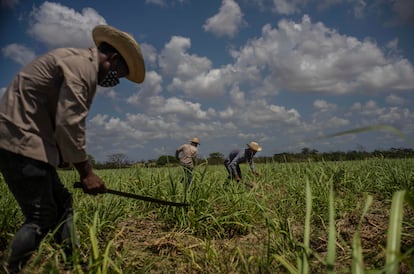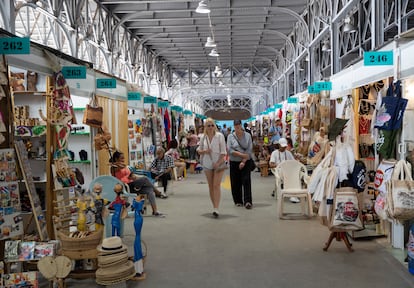In Cuba with no sugar, spotty internet, and frustrated Kardashians
The famous Caribbean adage, ‘without sugar, there is no country,’ is quickly becoming the reality on an island that faces shortages, emigration, and isolation

I met my friend Lázaro on the Alameda de Paula, the famous seaside promenade in Old Havana. We decided to enter the vast harborfront warehouse known as the Almacenes de San José, which today houses a large arts and crafts market for tourists. It also serves as the headquarters for the theater company of actor and director Osvaldo Doimeadiós, who just wrapped up a successful season of performances of El baile (“The Dance”), a drama by renowned Cuban playwright Abelardo Estorino that explores issues of emigration and divided families, of loneliness, and of the precariousness – material and spiritual – that shapes the lives of those who stay behind.
Built on the banks of Havana Bay in the mid-19th century, these old sugar warehouses boast one of the most beautiful views of the piers, and are an important part of the island’s history. Lázaro told me how back in those days, when Cuba was one of the largest sugar producers in the world, capitalist technological development and an increase in international production forced companies to compete with lower market prices, and the island’s docks, warehouses and railroads were integrated into a network, to save time and labor in the transportation and storage of sugar. That was when these impressive buildings were constructed, forever transforming the image of the port.

The Almacenes de San José extend along Desamparados St., near the church of San Francisco de Paula. After it was restored, the massive complex was reopened in 2009 as an arts and crafts market, and now houses some two to three hundred vendor stalls. The morning we met, small groups of tourists were wandering about, browsing the offerings and buying gifts to bring home. Lázaro spke to a woman from Spain as she purchased some souvenirs decorated with little Cuban flags, and told her about the history of the warehouses, what they were like 150 years ago, and the major role they came to play in the country’s economy, storing sugar directly off the rail lines and coastal shipping vessels.
“Oye, you’re giving her quite the earful, eh?” I told Lázaro as I pulled him away by the arm and ushered him to the nearest café. The history of sugar production had him all riled up. He ordered a coffee, but then poured in a splash of rum to make it a carajillo, and then I was the one getting an earful.
“In 1894, one year before Cuba’s third war of independence, the island was producing close to a million tons of sugar a year. By 1959, there were 156 sugar mills operating in the country, with a total annual production of 5.6 million tons. In the eighties, Cuba was producing an average of eight million tons per year. But this year, we’ll be lucky if we get 400,000 tons. It’s a national disaster,” he told me. Lázaro said that last year’s harvest was the worst on record, with a total of just 480,000 tons – the lowest in the last century and a half.

The dismantling of Cuba’s sugar industry began in 2002 under orders from Fidel Castro, and was aimed at restructuring the sector to make it more efficient. To this end, more than half of the 156 mills operating in the country, which employed around half a million people, were shuttered, and all remaining resources were concentrated in the 70 plants that remained, with a focus on achieving smaller but more productive harvests. “The experiment was a failure: tens of thousands of people lost their jobs, most of the mills disappeared, and production plummeted,” Lázaro told me. “Last year there were only 36 mills still in operation, and this year, that number has dropped to 23. The forecast for the 2022-2023 harvest was 400,000 tons of processed sugar, which is barely enough to satisfy national consumption, but at this rate they won’t even manage that much,” Lázaro went on, as he pulled out a Monday copy of Granma, Cuba’s national newspaper.
The official organ of the Communist Party of Cuba featured an interview with Ángel Luis Ríos, director of the state-owned sugar producer Azcuba Group, who admitted that the country currently faces “a 95,000-ton deficit below forecasted numbers.” Among the reasons Ríos identified for the shortage were “financial difficulties” in the guarantee of the necessary inputs, equipment failures and breakdowns, and a lack of fuel and spare parts to ensure reliable transportation and cane cutting (wheels and batteries, among others). All this in addition to the familiar effects of the US embargo. “This is the most interesting part,” said Lázaro, who then read me the following statement by Ríos, in Granma: “The problems are not only related to financial problems and equipment issues. Like other sectors of the economy, the sugar industry suffers from a shortage of personnel, for various reasons, but mainly due to the aging of the labor force and the effects of migration. The country’s current economic situation, marked by inflation, also plays a role. For example, production problems at a sugar mill prevent workers from receiving a decent salary, so many of them leave.”

Lázaro was outraged. He said that this month, in his neighborhood, “they only gave out” one pound of sugar, when the normal ration stipulated by the government’s “supplies booklet” is four pounds per person. “In the bodega, at subsidized prices, a pound of sugar costs eight Cuban pesos, but since there’s no sugar anywhere, people have to buy it on the black market for 100 or 150 pesos. Just imagine! A pension in Cuba is between 1,000 and 1,500 pesos!” Then Lázaro took a turn for the philosophical, quoting the famous Criollo landowner who once remarked: “without sugar, there is no country.” “Well,” said Lázaro, “we’ve reached the point where in the country of sugar, there is no sugar.”
Seeing that he was about to throw a fit, I invited Lázaro to join me for lunch in the beautiful San Francisco square, home to the elegant Café del Oriente. We ordered sandwiches, but even that didn’t calm him down. Lázaro was angry, and he started spewing data at me: “In 2021, of the total investments made by the state, 35.2% were for the construction of hotels and only 0.4% for the sugar sector. Investments in health were only 1.7%. These priorities have been maintained for years, so it’s no surprise that now there’s no sugar, or that infant mortality has almost doubled, or that life expectancy has been reduced by 7 years in just the last decade [from 78.5 to 71.25, according to calculations by Cuban demographer Juan Carlos Albizu-Campos].” “Eat your sandwich,” I told him. But he would not stop, not until he got stuck on a number and tried to Google it on his phone — but there was no service. He burst out: “On top of that, our internet is total crap!” Connectivity has always been bad in Cuba, but it’s gotten even worse in recent years. Just this week, the country’s monopoly telephone company, Etecsa, reported widespread service outages, and recommended that users who are “experiencing difficulties accessing the internet or making calls activate and deactivate airplane mode and try to reconnect to the network.”
“You know what Etecsa stands for?” Lázaro asked the waiter, and I could sense another joke coming. “It stands for Estamos Tratando de Comunicar Sin Apuro (We’re Not in a Hurry to Communicate).” The joke landed, and the waiter nearly dropped his tray from laughing so hard. “Shit, you don’t have to tell me, compadre,” the waiter said. “I’ve put my phone on airplane mode so many times it’s asking for my passport number!” To lighten the mood, I told them both not to complain, that until 2018, Cubans didn’t have any mobile data and the only places with Wi-Fi were a few public parks, where people had to sit around on curbs to catch a signal.
Lázaro cracked a smile and finally started to relax. “It’s true,” he said, and started to tell me about the time the Kardashians’ visited the island, in May 2016, after Obama’s historic visit. In those years, it seemed like the whole world was coming to Cuba: The Rolling Stones played to half a million people in Havana, and major US celebrities – Madonna, Beyoncé, the Kardashian sisters and others – arrived to the island in droves. Kim, Kourtney and Khloé traveled to the capital to film their reality show. They cruised down the malecón in a convertible, ate at a local paladar (a small, family run restaurant), visited the Museum of Rum, and took pictures of everything. But most of the time they were in a bad mood, because the internet quality was so lousy. “A guy I know was friends with their driver,” Lázaro said. “He told me how they were all super upset because they couldn’t send their photos and videos on Snapchat. These people live to upload their stories to social media, so they got upset and cut their trip short, and left in a hurry. They weren’t ready for Cuba.”

Lázaro admitted things are better now than they were before (“the internet is still total crap though”), and said that, “to be fair, the Americans screw up everything they can – just this December, the US Department of Justice told the Federal Communications Commission that they should deny a permit for the installation of the first underwater telecommunications cable that would’ve connected Cuba to the US – but it’s still true that when the government feels like it, or when there’s a protest like the one that happened on July 11, they shut down the internet across the island.”
I told him not to get all worked up again, and he looked at me sideways. “Ok, I’ll shut up, but you have to let me borrow a pound of sugar until the next rations come in,” he responded. “Oh, Lázaro, you never change!” I told him.
Sign up for our weekly newsletter to get more English-language news coverage from EL PAÍS USA Edition
Tu suscripción se está usando en otro dispositivo
¿Quieres añadir otro usuario a tu suscripción?
Si continúas leyendo en este dispositivo, no se podrá leer en el otro.
FlechaTu suscripción se está usando en otro dispositivo y solo puedes acceder a EL PAÍS desde un dispositivo a la vez.
Si quieres compartir tu cuenta, cambia tu suscripción a la modalidad Premium, así podrás añadir otro usuario. Cada uno accederá con su propia cuenta de email, lo que os permitirá personalizar vuestra experiencia en EL PAÍS.
¿Tienes una suscripción de empresa? Accede aquí para contratar más cuentas.
En el caso de no saber quién está usando tu cuenta, te recomendamos cambiar tu contraseña aquí.
Si decides continuar compartiendo tu cuenta, este mensaje se mostrará en tu dispositivo y en el de la otra persona que está usando tu cuenta de forma indefinida, afectando a tu experiencia de lectura. Puedes consultar aquí los términos y condiciones de la suscripción digital.
More information
Archived In
Últimas noticias
Maduro pleads not guilty before the federal court in New York: ‘I am still the president of Venezuela’
A new test can detect Alzheimer’s from a finger prick
UN team enters Sudanese city of El Fasher after paramilitary massacre: ‘It’s like a ghost town’
A recipe for resistance: Indigenous peoples politicize their struggles from the kitchen
Most viewed
- Gilles Lipovetsky: ‘If you want to live better and fall in love, take Prozac, don’t look to philosophy’
- Alain Aspect, Nobel laureate in physics: ‘Einstein was so smart that he would have had to recognize quantum entanglement’
- Alvin Hellerstein, a 92-year-old judge appointed by Bill Clinton, to preside over Maduro’s trial in New York
- Why oil has been at the center of Venezuela-US conflicts for decades
- Maduro’s downfall puts China’s relationship with Venezuela to the test









































